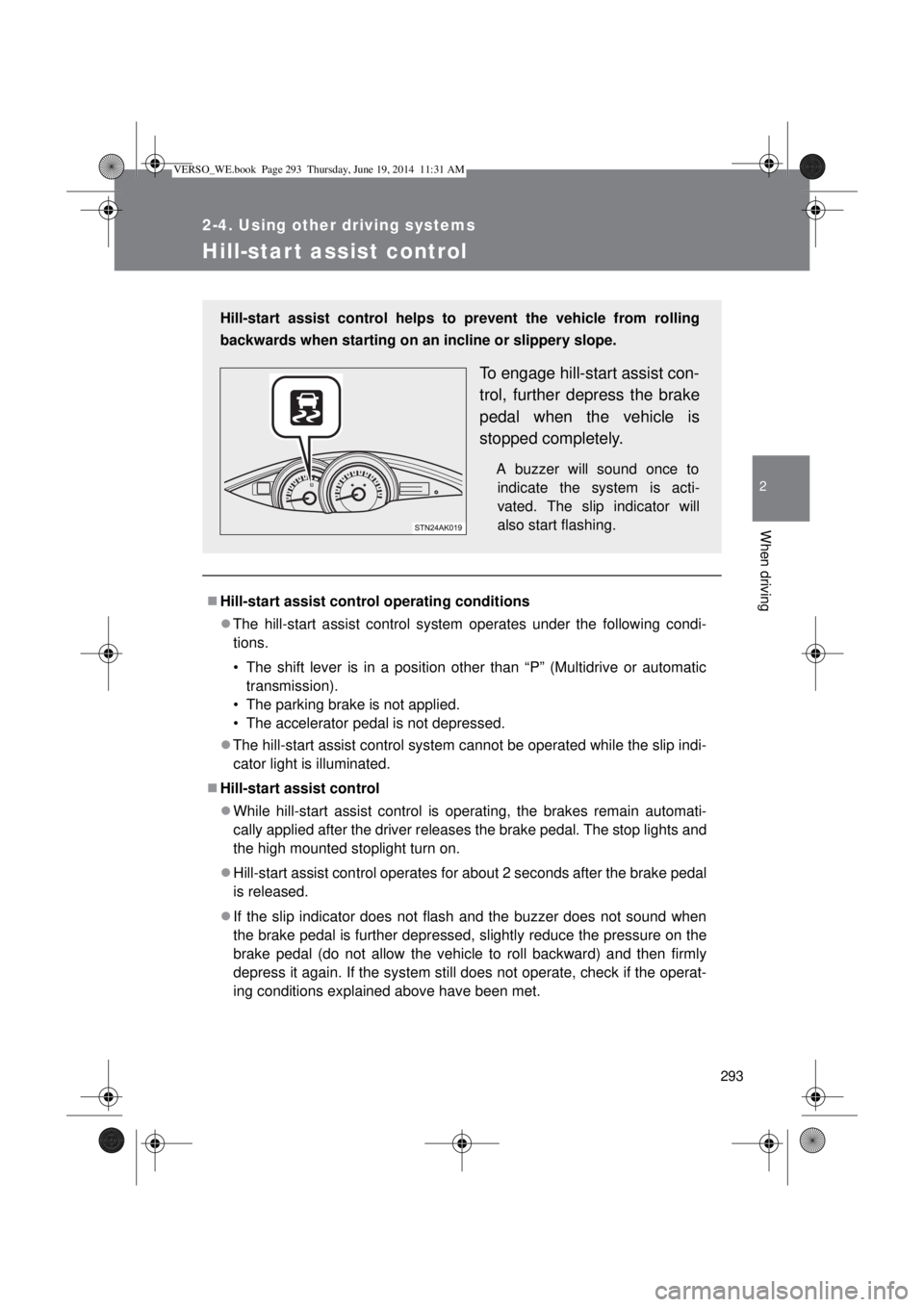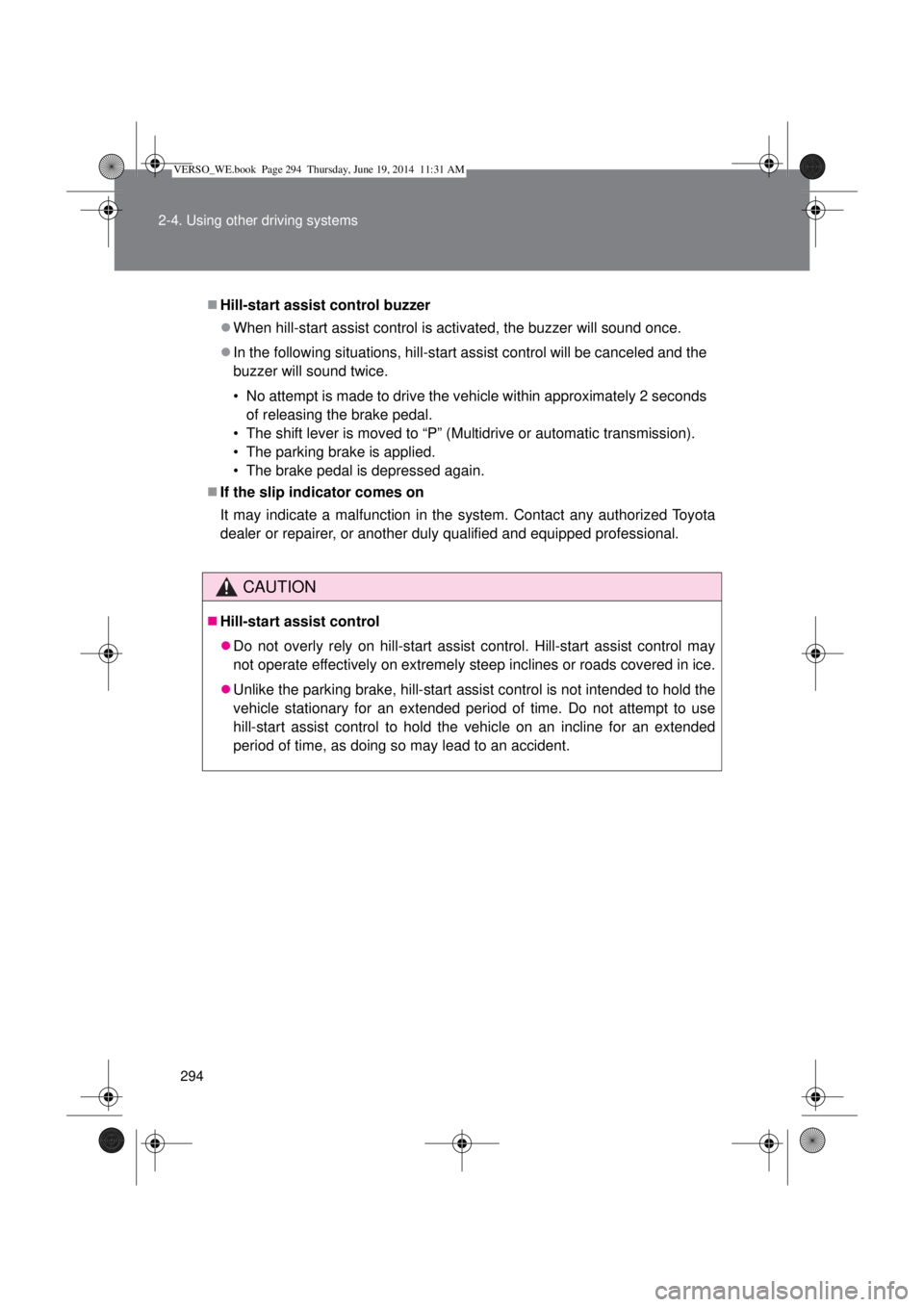Page 273 of 650
273 2-4. Using other driving systems
2
When driving
Display
When the sensors detect an obstacle, the Toyota parking assist-sen-
sor indicator is illuminated by an LED depending on position and dis-
tance to the obstacle.
Front center sensor operation
Front corner sensor operation
Rear corner sensor operation
Rear center sensor operation
The light comes on to indicate
that the system is operating
The distance display and buzzer
When a sensor detects an obstacle, the direction of and the approxi-
mate distance to the obstacle are displayed and the buzzer sounds.
Sensor operation and distance to an obstacle
The system operates when the vehicle approaches an obstacle, as
shown by the following table.
VERSO_WE.book Page 273 Thursday, June 19, 2014 11:31 AM
Page 276 of 650

276 2-4. Using other driving systems
Detection range of the sensors
Approximately 100 cm (3.2 ft.)
Approximately 150 cm (4.9 ft.)
Approximately 60 cm (2.0 ft.)
The diagram shows the detection
range of the sensors. Note that
the sensors cannot detect obsta-
cles that are extremely close to
the vehicle.
The range of the sensors may
change depending on the shape
of the object etc.
The Toyota parking assist-sensor can be operated when
The Toyota parking assist-sensor switch is on.
Vehicles without smart entry & start system:
The engine switch is in “ON” position.
Vehicles with smart entry & start system:
The “ENGINE START STOP” switch is in IGNITION ON mode.
Front center sensors:
• The shift lever is in a position other than “P” (Multidrive or automatic
transmission) or “R”.
• The vehicle speed is less than about 10 km/h (6 mph).
Front corner sensors:
• The shift lever is in a position other than “P” (Multidrive or automatic
transmission).
• The vehicle speed is less than about 10 km/h (6 mph).
VERSO_WE.book Page 276 Thursday, June 19, 2014 11:31 AM
Page 277 of 650

277 2-4. Using other driving systems
2
When driving
Rear corner and rear center sensors:
• The shift lever is in “R”.
Sensor detection information
Certain vehicle conditions and the surrounding environment may affect
the ability of a sensor to correctly detect an obstacle. Particular instances
where this may occur are listed below.
• There is dirt, snow or ice on a sensor.
• A sensor is frozen.
• A sensor is covered in any way.
• The vehicle is leaning considerably to one side.
• On an extremely bumpy road, on an incline, on gravel, or on grass.
• The vicinity of the vehicle is noisy due to vehicle horns, motorcycle
engines, air brakes of large vehicles, or other loud noises producing
ultrasonic waves.
• There is another vehicle equipped with parking assist sensors in the
vicinity.
• A sensor is coated with a sheet of spray or heavy rain.
• The vehicle is equipped with a fender pole or radio antenna.
• Towing eyelet is installed.
• A bumper or sensor receives a strong impact.
• The vehicle is approaching a tall or right-angled curb.
• In harsh sunlight or intense cold weather.
• A non-genuine Toyota suspension (lowered suspension etc.) is
installed.
In addition to the examples above, there are instances in which, because of
their shape, signs and other objects may be judged by a sensor to be closer
than they are.
The shape of the obstacle may prevent a sensor from detecting it. Pay
particular attention to the following obstacles:
• Wires, fences, ropes, etc.
• Cotton, snow and other materials that absorb sound waves
• Sharply-angles objects
• Low obstacles
• Tall obstacles with upper sections projecting outwards in the direction
of your vehicle
VERSO_WE.book Page 277 Thursday, June 19, 2014 11:31 AM
Page 278 of 650

278 2-4. Using other driving systems
When the sensor acts abnormal or malfunctions
Customization that can be configured at any authorized Toyota dealer
or repairer, or another duly qualified and equipped professional
Setting of buzzer volume can be changed.
(Customizable featuresP. 629)
CAUTION
Caution when using the Toyota parking assist-sensor
Observe the following precautions.
Failing to do so may result in the vehicle being unable to be driven safely
and possibly cause an accident.
Do not use the sensor at speeds in excess of 10 km/h (6 mph).
Do not attach any accessories within the sensor range.
When any of the sensors become dirty
or frozen, the abnormal sensor indica-
tor comes on and the buzzer sounds for
8 seconds. After sounding, all of the
sensor indicators will come on.
Clean the sensors with soft cloth.
When any of the sensors malfunction,
the malfunctioning sensor indicator
flashes and the buzzer will sound for 8
seconds. After sounding, all of the sen-
sor indicators will flash.
Have the vehicle inspected by any
authorized Toyota dealer or repairer,
or another duly qualified and
equipped professional. Sensor indicators
VERSO_WE.book Page 278 Thursday, June 19, 2014 11:31 AM
Page 293 of 650

293
2-4. Using other driving systems
2
When driving
Hill-star t assist control
Hill-start assist control operating conditions
The hill-start assist control system operates under the following condi-
tions.
• The shift lever is in a position other than “P” (Multidrive or automatic
transmission).
• The parking brake is not applied.
• The accelerator pedal is not depressed.
The hill-start assist control system cannot be operated while the slip indi-
cator light is illuminated.
Hill-start assist control
While hill-start assist control is operating, the brakes remain automati-
cally applied after the driver releases the brake pedal. The stop lights and
the high mounted stoplight turn on.
Hill-start assist control operates for about 2 seconds after the brake pedal
is released.
If the slip indicator does not flash and the buzzer does not sound when
the brake pedal is further depressed, slightly reduce the pressure on the
brake pedal (do not allow the vehicle to roll backward) and then firmly
depress it again. If the system still does not operate, check if the operat-
ing conditions explained above have been met. Hill-start assist control helps to prevent the vehicle from rolling
backwards when starting on an incline or slippery slope.
To engage hill-start assist con-
trol, further depress the brake
pedal when the vehicle is
stopped completely.
A buzzer will sound once to
indicate the system is acti-
vated. The slip indicator will
also start flashing.
VERSO_WE.book Page 293 Thursday, June 19, 2014 11:31 AM
Page 294 of 650

294 2-4. Using other driving systems
Hill-start assist control buzzer
When hill-start assist control is activated, the buzzer will sound once.
In the following situations, hill-start assist control will be canceled and the
buzzer will sound twice.
• No attempt is made to drive the vehicle within approximately 2 seconds
of releasing the brake pedal.
• The shift lever is moved to “P” (Multidrive or automatic transmission).
• The parking brake is applied.
• The brake pedal is depressed again.
If the slip indicator comes on
It may indicate a malfunction in the system. Contact any authorized Toyota
dealer or repairer, or another duly qualified and equipped professional.
CAUTION
Hill-start assist control
Do not overly rely on hill-start assist control. Hill-start assist control may
not operate effectively on extremely steep inclines or roads covered in ice.
Unlike the parking brake, hill-start assist control is not intended to hold the
vehicle stationary for an extended period of time. Do not attempt to use
hill-start assist control to hold the vehicle on an incline for an extended
period of time, as doing so may lead to an accident.
VERSO_WE.book Page 294 Thursday, June 19, 2014 11:31 AM
Page 479 of 650
479 4-3. Do-it-yourself maintenance
4
Maintenance and care
Under the instrument panel (type A)
FuseAmpereCircuit
1 TAIL 10 AFront position lights, tail lights,
license plate lights, rear fog light,
front fog lights, manual headlight
leveling system, instrument cluster
lights, glove box light, switch illumi-
nation, Toyota parking assist-sen-
sor ECU
2 ECU-IG NO.3 10 APanoramic roof shade, auto anti-
glare inside rear view mirror, smart
entry & start system, audio system,
Stop & Start system
*3
3 FR DOOR 20 APower windows (front passenger
side)
4 RL DOOR 20 A Power windows (rear left)
5 RR DOOR 20 A Power windows (rear right)
6 CIG 15 A Power outlets
7 ACC 7.5 AShift lock system, audio system,
main body ECU, power outlet, out-
side rear view mirrors, Stop & Start
system
*3
8 MIR HTR 10 A Outside rear view mirror defoggers
9 RR FOG 7.5 A Rear fog light
VERSO_WE.book Page 479 Thursday, June 19, 2014 11:31 AM
Page 480 of 650

480 4-3. Do-it-yourself maintenance
10 IGN 7.5 ASteering lock system, SRS airbag
system, multiport fuel injection sys-
tem/sequential multiport fuel injec-
tion system, automatic
transmission
*1, starting system
11 METER 7.5 AGauges and meters, Stop & Start
system
*3
12 SEAT HTR 15 A Seat heaters
13 HTR-IG 10 AAir conditioning system, power
heater
14 WIPER 25 AWindshield wipers, rain-sensing
windshield wipers
15 RR WIPER 15 A Rear window wiper
16 WASHER 15 AWindshield washers, rear window
washer
17 ECU-IG NO.1 10 AMain body ECU
*4, electric cooling
fan(s), shift lock system, anti-lock
brake system, steering sensor, yaw
rate sensor, VSC+, headlight
cleaners, SEQUENTIAL switch,
automatic headlight leveling sys-
tem, electric power steering, tire
pressure warning system
18 ECU-IG NO.2 10 ABack-up light, charging system
*4,
emergency flashers, rear window
defogger, “PASSENGER AIRBAG”
indicator, air conditioning system,
Toyota parking assist-sensor indi-
cator, Toyota parking assist-sensor
switch
19 OBD 7.5 A On-board diagnosis system
FuseAmpereCircuit
VERSO_WE.book Page 480 Thursday, June 19, 2014 11:31 AM